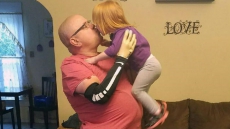TORONTO — With ghosts and goblins preparing to haunt the streets of Canada's cities this Halloween, the good news is it's possible to have a ghoulishly good time without generating a lot of waste.
By observing the three Rs — reduce, reuse and recycle — when it comes to costumes, decorations and treats, enjoyment of the holiday needn't be sacrificed.
"There could be some arguments that you don't celebrate it at all and you shut your light off and don't do anything — that's the least wasteful you can possibly be," says Emma Rohmann, an environmental engineer and green building consultant who runs the company Green at Home in Toronto.
"But I think part of green living is getting into some of the cultural activities that you enjoy and I happen to like Halloween so we do get into it" in a low-key way.
Katelin Leblond, co-founder of PAREdown, a website that documents going back to basics with zero-waste living, tries not to make trick-or-treating the focus of Halloween for her five-year-old son and three-year-old daughter.
"We'll carve pumpkins and will see if they can find a local activity like a corn maze that doesn't require waste generation," she says.

Last year, when the Leblond family lived in Victoria, they went to a bonfire put on by the fire department. This year, Leblond's children will don a mermaid costume and a biker costume found at a secondhand store for a total of about $18. No face paint will be used and the costumes will be donated afterward.
Rohmann makes costumes for her five-year-old daughter and two-year-old son or shops at nearby consignment stores.
"Luckily my daughter was a ghost last year so that was manageable. We do hand-me-down costumes.... I've got two kids now so my son is reusing my daughter's costumes for the most part."
Rohmann also reuses simple Halloween decorations each year.
"I try not to get stuff like crepe paper or the cobwebs or things that aren't going to last as long," says Rohmann, who has also volunteered with the Queen of Green coaching program with the David Suzuki Foundation. Though lawn tombstones and outdoor skeletons are plastic, their life cycle is longer.
"You're not using energy to keep them inflated or the lights to keep them lit up, so I think it's a lower-footprint way of doing it."
They both advocate taking the non-food route when it comes to handing out treats at the door.
Rohmann is giving out Halloween-themed pencils, though she plans to buy some candy to have on hand for older kids.

"I know we can never have enough art supplies in the house — pencils, crayons, notebooks, that sort of thing. I'm going for practical," she says.
Both women suggest avoiding impractical dollar-store trinkets, which can become clutter and end up in landfill.
For candy, look for a type packaged in a recyclable cardboard box such as Smarties, which are also peanut free.
The wrappers on individually wrapped chocolate bars can't be recycled, but some communities can accommodate the cellophane from candy like lollipops in their soft plastic recycling program.
If the opportunity arises, Leblond's son will choose plastic-free packaged treats when trick-or-treating.
"Even if the homeowner doesn't have any plastic-free treats to provide this year it may provide food for thought for coming years," she says.
To collect their loot, children can use a pillowcase or reusable cloth shopping bag. Leblond's son uses a Halloween pail they had before they started their zero-waste lifestyle and her daughter uses an Easter basket.
An alternative to handing out candy is to donate to the Trick or Eat program, an initiative aimed at fighting hunger.
"Volunteers collect food and other goods such as diapers and feminine hygiene products and raise awareness about hunger issues on people's doorsteps, then deliver goods to a local aid agency," says Sarah Archibald, program manager of the non-profit, youth-driven charity Meal Exchange, which runs Trick or Eat.

There are at least 85 campaigns running across the country. Last year, about 3,800 participants raised $380,000 worth of food, says Archibald. In total, $5 million worth of food has been raised over the 15 years the program has been running.
A Calgary dental office is also trying to reduce Halloween waste by asking kids to trade in their candy. Children can bring in their booty to Evans Dental Health & Wellness on Nov. 1 for the Halloween Candy Buy Back program.
The child gets $1 for every pound of candy and the dental service donates a pound of apples to the local food bank. This year, they are shipping the candy to the California company Blume Distillation to be converted to biofuel.
The program has been running for nine years. Last year, 2,500 pounds of apples were donated.




